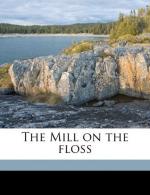|
This section contains 8,494 words (approx. 29 pages at 300 words per page) |

|
SOURCE: "A Story of Nature: The Mill on the Floss," in Modern Novelists: George Eliot, St. Martin's Press, 1993, pp. 43-62.
Below, Bellringer contends that the conclusion of The Mill on the Floss is suitable to the story.
The Mill on the Floss (1860) followed rapidly on Adam Bede, an altogether darker companion-piece, the characters being on a lower level generally, and the environment less romantic,' as the author herself remarked.
Set thirty years on from her first novel, it leaves the fertile slopes of the Midland shires for the hazardous watery plains to the east, where the Ripple runs into the Floss south of the Mudport estuary, whose tide, 'the awful Eagre', checks the impetuous current, coming up against it in spring 'like a hungry monster'. The constant fear of the riparian population there is of drowning. Dependent on wharf, water-wheel and black boats, it takes risks and...
|
This section contains 8,494 words (approx. 29 pages at 300 words per page) |

|


